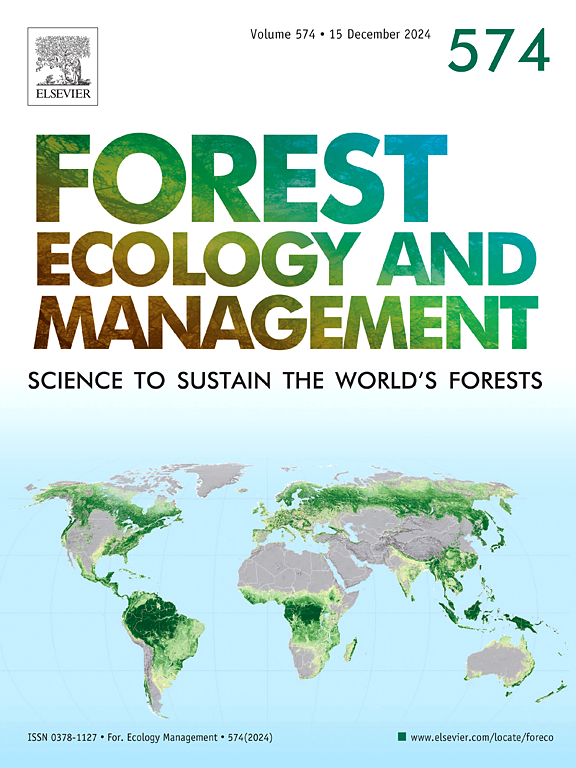落基山脉南部陡坡抢救性伐木后的燃料负荷
IF 3.7
2区 农林科学
Q1 FORESTRY
引用次数: 0
摘要
最近在北美西部爆发的树皮甲虫由于其频率、影响和地理范围引起了人们的关注。这些暴发会增加燃料负荷,从而增加发生强烈野火的风险。在南落基山脉地区,树皮甲虫的爆发导致了数百万棵枯死的树木,促使人们考虑抢救治疗。许多这些处理将在陡坡上进行,使用创新的收获设备,如绞车辅助的切割长度收割机,去除站立的死茎。虽然回收处理旨在恢复经济价值并降低火灾风险,但这些处理的生态影响仍未得到充分研究,包括它们对野火木质燃料负载的影响。我们的研究考察了绞车辅助切割长度打捞收获对燃料负荷的影响,在亚高山和山地森林在科罗拉多州南部。我们对经过处理和未经处理的9个林分的燃料负荷进行了评估,发现在山地和亚高山森林中,回收性采伐显著增加了大多数细木质表面燃料。我们还记录到,山地和亚高山冠层的枯死燃料减少了90% %以上。我们没有观察到两种森林类型在粗木本材料(CWM)负荷上的显著差异。我们的研究结果表明,绞车辅助打捞采伐可能会降低树冠火灾的概率,但可能会增加地面火灾的风险。本文章由计算机程序翻译,如有差异,请以英文原文为准。
Fuel loading after steep slope salvage logging in the southern Rocky Mountains
Recent bark beetle outbreaks in western North America have raised concerns due to their frequency, impact, and geographic extent. These outbreaks can pose a heightened risk of intense wildfires by increasing the fuel load. In the Southern Rocky Mountain region, bark beetle outbreaks have led to millions of standing dead trees, prompting consideration of salvage treatments. Many of these treatments would occur on steep slopes using innovative harvesting equipment, such as winch-assisted cut-to-length harvesters, to remove standing dead stems. While salvage treatments aim to recover economic value and reduce fire risk, the ecological impacts from these treatments remain understudied, including what impact they have on wildfire woody fuel loading. Our study examined the impacts of winch-assisted cut-to-length salvage harvesting on fuel loads in subalpine and montane forest in southern Colorado. We assessed fuel loads in nine forest stands in treated and untreated areas and found that salvage logging significantly increased most fine woody surface fuels in both montane and subalpine forests. We also recorded a reduction of the standing dead fuels in montane and subalpine canopies by over 90 %. We did not observe significant differences in coarse woody material (CWM) loads for either forest type. Our results indicate that winch-assisted salvage logging may reduce the probability of canopy fires, while potentially increasing the risk of ground fires.
求助全文
通过发布文献求助,成功后即可免费获取论文全文。
去求助
来源期刊

Forest Ecology and Management
农林科学-林学
CiteScore
7.50
自引率
10.80%
发文量
665
审稿时长
39 days
期刊介绍:
Forest Ecology and Management publishes scientific articles linking forest ecology with forest management, focusing on the application of biological, ecological and social knowledge to the management and conservation of plantations and natural forests. The scope of the journal includes all forest ecosystems of the world.
A peer-review process ensures the quality and international interest of the manuscripts accepted for publication. The journal encourages communication between scientists in disparate fields who share a common interest in ecology and forest management, bridging the gap between research workers and forest managers.
We encourage submission of papers that will have the strongest interest and value to the Journal''s international readership. Some key features of papers with strong interest include:
1. Clear connections between the ecology and management of forests;
2. Novel ideas or approaches to important challenges in forest ecology and management;
3. Studies that address a population of interest beyond the scale of single research sites, Three key points in the design of forest experiments, Forest Ecology and Management 255 (2008) 2022-2023);
4. Review Articles on timely, important topics. Authors are welcome to contact one of the editors to discuss the suitability of a potential review manuscript.
The Journal encourages proposals for special issues examining important areas of forest ecology and management. Potential guest editors should contact any of the Editors to begin discussions about topics, potential papers, and other details.
 求助内容:
求助内容: 应助结果提醒方式:
应助结果提醒方式:


